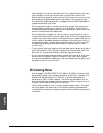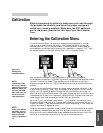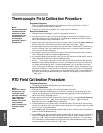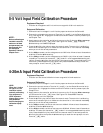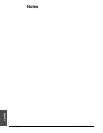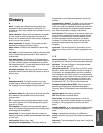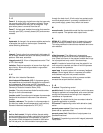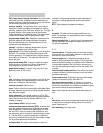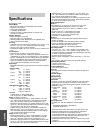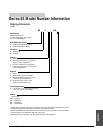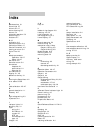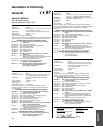
Watlow Series 93 Appendix ■ A.9
Glossary
A
alarm A signal that indicates that the process has
exceeded or fallen below the set or limit point. For
example, an alarm may indicate that a process is too hot
or too cold.
alarm, deviation Warns that a process has exceeded
or fallen below a certain range around the set point.
Alarms can be referenced at a fixed number of degrees,
plus or minus, from set point.
alarm hysteresis A change in the process variable
required to re-energize the alarm output.
alarm silence A feature that disables the alarm relay
output.
anti-reset A control feature that inhibits automatic reset
action outside the proportional band. Also called anti-
reset windup.
anti-reset windup The feature of a PID temperature
controller that prevents the integral (automatic reset) cir-
cuit from functioning when the temperature is outside
the proportional band. This standard feature helps stabi-
lize a system. Also called anti-reset.
automatic prompts Data entry points where a micro-
processor-based controller asks the operator to enter a
control value.
B
bumpless transfer A smooth transition from auto
(closed loop) to manual (open loop) operation. The con-
trol output(s) does not change during the transfer.
C
calibration offset An adjustment to eliminate the differ-
ence between the indicated value and the actual
process value.
CE A manufacturer’s mark that demonstrates compli-
ance with European Union (EU) laws governing prod-
ucts sold in Europe.
CE-compliant Compliant with the essential require-
ments of European directives pertaining to safety and/or
electromagnetic compatibility.
closed loop A control system that uses a sensor to
measure a process variable and makes decisions based
on that input.
cold junction See junction, cold.
cold junction compensation Electronic means to
compensate for the effective temperature at the cold
junction.
compensation, ambient The ability of an instrument to
adjust for changes in the temperature of the environ-
ment and correct the readings. Sensors are most accu-
rate when maintained at a constant ambient tempera-
ture. When temperature changes, output drifts.
control action The response of the control output rela-
tive to the error between the process variable and the
set point. For reverse action (usually heating), as the
process decreases below the set point, the output
increases. For direct action (usually cooling), as the
process increases above the set point, the output
increases.
cycle time The time required for a controller to com-
plete one on-off-on cycle. It is usually expressed in sec-
onds.
D - E
default parameters The programmed instructions that
are permanently stored in the microprocessor software.
derivative The rate of change in a process variable.
Also known as rate. See PID.
derivative control (D) The last term in the PID control
algorithm. Action that anticipates the rate of change of
the process, and compensates to minimize overshoot
and undershoot. Derivative control is an instantaneous
change of the control output in the same direction as the
proportional error. This is caused by a change in the
process variable (PV) that decreases over the time of
the derivative (TD). The TD is in units of seconds.
Deutsche Industrial Norm (DIN) A set of technical,
scientific and dimensional standards developed in
Germany. Many DIN standards have worldwide recogni-
tion.
deviation alarm See alarm, deviation.
DIN See Deutsche Industrial Norm.
direct action An output control action in which an
increase in the process variable causes an increase in
the output. Cooling applications usually use direct
action.
display capability In an instrument with digital display,
the entire possible span of a particular parameter or
value.
droop In proportional controllers, the difference
between set point and actual value after the system sta-
bilizes.
duty cycle The percentage of a cycle time in which the
output is on.
Appendix




